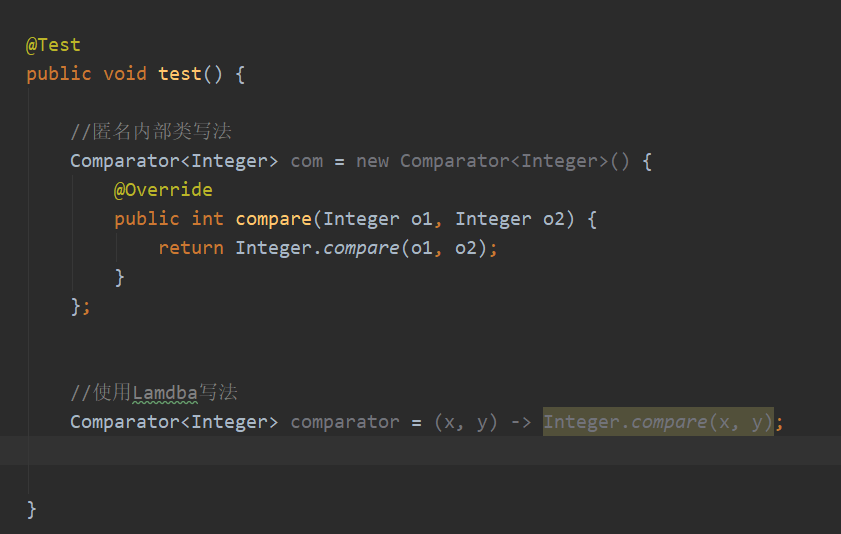Lamdba表达式 主要作用替代匿名内部类 达到简化代码的操作
.png)

Lamdba表达式 在对象中的使用
Employee类
.png)
.png)
需求1:得到年龄大于18的员工信息
定义方法
.png)
测试类
.png)
结果
.png)
需求2:得到薪水大于10000的员工信息
定义方法
.png)
测试类
.png)
结果
.png)
总结以上方法 代码重复较多
开始优化使用函数式接口
1.自定义一个函数式接口
.png)
作用 模仿 java8中Predicate 函数式接口
.png)

.png)
该接口定义一个泛型 返回布尔值
2.定义一个公用方法 (两个需求的方法都能调用)
自定义函数式接口 MyPredicate 泛型放入Employee
(作用是后面使用Lamdba表达式,更加说明了Lamdba表达式使用依赖函数式接口)
.png)
3.test01 test02 调用公用方法 使用匿名内部类
传入 准备的数据 list new 函数式接口
在匿名内部类的方法中 实现各自需求 (age>18 salary>10000)
.png)
结果
.png)
.png)
3.使用Lamdba表达式
替代匿名内部类
.png)
具体替换内容 test01 与 test 04 替换相同
test02 与 test03替换内容 Lamdba表达式 替换 匿名内部类
.png)

1 package com.wf.zhang.java8.lamdba; 2 3 public class Employee { 4 5 private String name; 6 7 private int age; 8 9 private double salary; 10 11 public String getName() { 12 return name; 13 } 14 15 public void setName(String name) { 16 this.name = name; 17 } 18 19 public int getAge() { 20 return age; 21 } 22 23 public void setAge(int age) { 24 this.age = age; 25 } 26 27 public double getSalary() { 28 return salary; 29 } 30 31 public void setSalary(double salary) { 32 this.salary = salary; 33 } 34 35 public Employee() { 36 37 } 38 39 public Employee(String name, int age, double salary) { 40 this.name = name; 41 this.age = age; 42 this.salary = salary; 43 } 44 45 @Override 46 public String toString() { 47 return "Employee{" + 48 "name='" + name + '\'' + 49 ", age=" + age + 50 ", salary=" + salary + 51 '}'; 52 } 53 }

1 package com.wf.zhang.java8.lamdba; 2 3 @FunctionalInterface 4 public interface MyPredicate<T> { 5 6 public boolean test(T t); 7 }

1 package com.wf.zhang.java8.lamdba; 2 3 import org.junit.Test; 4 5 import java.util.ArrayList; 6 import java.util.Arrays; 7 import java.util.Comparator; 8 import java.util.List; 9 10 public class TestLamdba3 { 11 12 @Test 13 public void test() { 14 15 //匿名内部类写法 16 Comparator<Integer> com = new Comparator<Integer>() { 17 @Override 18 public int compare(Integer o1, Integer o2) { 19 return Integer.compare(o1, o2); 20 } 21 }; 22 23 24 //使用Lamdba写法 25 Comparator<Integer> comparator = (x, y) -> Integer.compare(x, y); 26 27 28 } 29 30 31 //准备数据 32 List<Employee> list = Arrays.asList( 33 new Employee("张飞", 18, 5000.00), 34 new Employee("赵云", 28, 6666.66), 35 new Employee("关羽", 38, 7777.77), 36 new Employee("刘备", 48, 10000.88) 37 ); 38 39 40 //得到年龄大于18 41 public List<Employee> getEmployeeByAge(List<Employee> list) { 42 43 List<Employee> emps = new ArrayList<>(); 44 45 for (Employee employee : list) { 46 if (employee.getAge() > 18) { 47 emps.add(employee); 48 } 49 } 50 51 return emps; 52 } 53 54 55 //工资大于5000 56 public List<Employee> getEmployeeBySalary(List<Employee> list) { 57 58 List<Employee> emps = new ArrayList<>(); 59 60 for (Employee employee : list) { 61 if (employee.getSalary() > 10000) { 62 emps.add(employee); 63 } 64 } 65 66 return emps; 67 } 68 69 70 @Test 71 public void testEmpAge() { 72 List<Employee> employeeByAge = getEmployeeByAge(list); 73 for (Employee employee : employeeByAge) { 74 System.out.println(employee); 75 } 76 } 77 78 @Test 79 public void testEmpSalay() { 80 List<Employee> employeeByAge = getEmployeeBySalary(list); 81 for (Employee employee : employeeByAge) { 82 System.out.println(employee); 83 } 84 } 85 86 87 //公用方法 88 public List<Employee> filterEmployee(List<Employee> emps, MyPredicate<Employee> mp) { 89 List<Employee> list = new ArrayList<>(); 90 91 for (Employee employee : emps) { 92 if (mp.test(employee)) { 93 list.add(employee); 94 } 95 } 96 97 return list; 98 } 99 100 101 @Test 102 public void test01() { 103 List<Employee> employeeByAge = filterEmployee(list, new MyPredicate<Employee>() { 104 @Override 105 public boolean test(Employee employee) { 106 return employee.getAge() > 18; 107 } 108 }); 109 for (Employee employee : employeeByAge) { 110 System.out.println(employee); 111 } 112 } 113 114 @Test 115 public void test02() { 116 List<Employee> employeeByAge = filterEmployee(list, new MyPredicate<Employee>() { 117 @Override 118 public boolean test(Employee employee) { 119 return employee.getSalary() > 10000; 120 } 121 }); 122 123 for (Employee employee : employeeByAge) { 124 System.out.println(employee); 125 } 126 } 127 128 129 @Test 130 public void test03() { 131 List<Employee> employeeByAge = filterEmployee(list, (e) -> e.getAge() > 18); 132 employeeByAge.forEach(System.out::println); 133 } 134 135 @Test 136 public void test04() { 137 List<Employee> employeeBySalary = filterEmployee(list, (t) -> t.getSalary() > 5000); 138 employeeBySalary.forEach(System.out::println); 139 } 140 }
